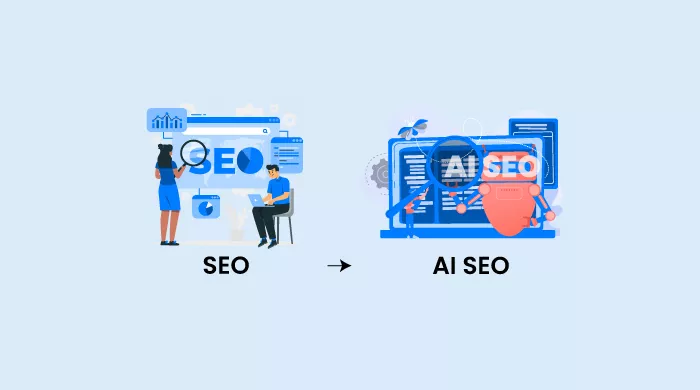"If you fell down yesterday, stand up today," said Herbert George Wells, an English writer identified as 'the Shakespeare of Science Fiction. '
Wells must have quoted this predicting the scenario of businesses today. In online business, you may have lost the race a few days back, but with the right Search Engine Optimization or SEO, you will regain the power to bounce back and race ahead. Spiders and Crawlers are happy with the right SEO.
After all, an optimized website or web page is directly linked to the online visibility in the SERPs (search engine results page) and convertible traffic that eventually contributes towards a successful digital business.
Search engines are the consoles, and optimization is the lifeline for business growth.
Whether you're familiar or not familiar with SEO, take it from us, it can go wrong anytime with a slight ignorance.
So, how do you know if you are going wrong with SEO? How can you fix this before it gets worse?
Here, we have attempted to help you understand how you can go wrong with SEO, how to fix it, some of the best practices, the benefits of using SEO software, current trends, and much more.
A Few Common SEO Mistakes in Traffic Generation and Tips to Fix Them
Hundreds of websites are indexed in search engines every single day. There's no doubt that having a robust and accurate SEO strategy is a prerequisite for yielding better rankings in the SERPs. But, with the constant evolution of the algorithms, it is not easy to maintain them consistently. One mistake could sabotage all the efforts you have put into implementing the strategies. Here are a few mistakes to avoid for traffic generation, and with a bit of work, you can fix them as well.
Low-Quality Content
Low-quality content, also known as thin content, is one of the major concerns responsible for the drop in traffic. Many companies curate content just for the sake of posting it and do not provide useful information to users. This hampers the traffic and overall visibility of your website in the eyes of search engines.

Source: Giftblooms
Possible Fix
- There are many ways of fixing the quality of the content. But before fixing the problem, it is essential to remember that visitors are human beings and not bots. Therefore, your content writing quality and techniques should revolve around providing high value to the reader.
- One way of fixing the poor quality content is to identify the weak content on the website. For this, you can go to Google and enter site:websitename.com to check which pages are indexed.
- If it is not indexed, then there are high stakes that the content is duplicated, plagiarized, or does not provide any useful information. Here's where revamping the old content comes into the picture.
- We suggest you use a generic tone and avoid using jargon phrases that go beyond understanding. When you are curating the content, give credit to the original sources of the information. Simply copy-pasting the content is a strict red flag. It can even result in a penalty for your website. Google frequently provides necessary guidelines from time to time through its algorithm updates.
- If you are presenting information to the users, create an outline using the 5Ws, that is, WHY, WHO, WHEN, WHERE, and WHAT in terms of the content. This will aid you in an apt way for content curation.
Broken Links
Every once in a while, there are odds that your website will have at least one broken link. Therefore, marketers should consistently keep a check on the state of inbound and outbound links.
Websites often run in 404 errors. There are multiple reasons for it. Blog URLs were tweaked, the content was removed, redesigning of the website was done, and so forth. Broken links refer to hyperlink that no longer redirects to the intended destination. When a visitor lands on a 404 page and does not receive any information, will they go back to your site again? Will they trust your online authority and keep surfing your website to find the desired information?
Here's an example of a broken link.

Source - Google
Possible Fixes
- You can easily rectify the broken links by using any of the web tools available on the internet. Many of the website platforms also provide broken link checker plugins to run this test.
Images without Alt texts
Images make the webpage attractive and make it easy for the users to understand the concept. However, for individuals who are visually impaired or blind, for them, it becomes difficult to navigate through the meaning of the image.
Here's where the Image Alt Text or Alternative Text comes into play. The alt text describes the function or the meaning of the image. Users who have disabilities can understand the meaning of the image through a screen reader application.
In the SEO context, it is mandatory to add alt text in the image as in compliance with website accessibility standards (WCAG). To check whether the image has alt text or not, point to the image and right-click and check inspect. A new pane will appear with the HTML code. You can view the text and verify if it has ALT text available or not.
Here's an example of an image without Alt Text

Source - Image Alt Tag Checker
Possible Fixes
- First things first, describe the purpose of the image in a few words in a concise manner.
- Avoid adding “image of…” or “photo of…”
- Always start the Alt text with capital letters and end it with a period. This gives a chance to the reader to pause after reading the text.
- Carefully craft the placement of the keyword in the image.
- If there are multiple images, the target is the main core keyword.
Copied Content
Companies are well-versed in the fact that they have to publish content frequently.
Since they are unable to churn the content, they publish the content by copying it from another website. It is a serious technical issue that can highly affect web page rankings.
Here's an example of copied content.

Source - QueText
Possible Fixes
- The first step in fixing the copied content is to find the pages where the visitors take a U-turn. Check the pages which have high bounce rates. There is a possibility that the content is not relevant to the user information. Re-write them and make them as creative, reliable, and user-centric original content.
- One way of reducing the bounce rate is to add a Call To Action at the end of the blog. Alongside this, provide precise and accurate information regarding your services/products to build trust-worthy relationships with the customer.
- Additionally, you can fix the copied content mistake by running your content through different tools to ensure that it's not repeated anywhere.
Outdated Information
We live in a world where the latest information is constantly changing and available at the tap of a finger. Providing wrong information or outdated information per se could mislead the users and negatively impact your brand and overall rankings in the SERPs.
Here's an example of outdated information.
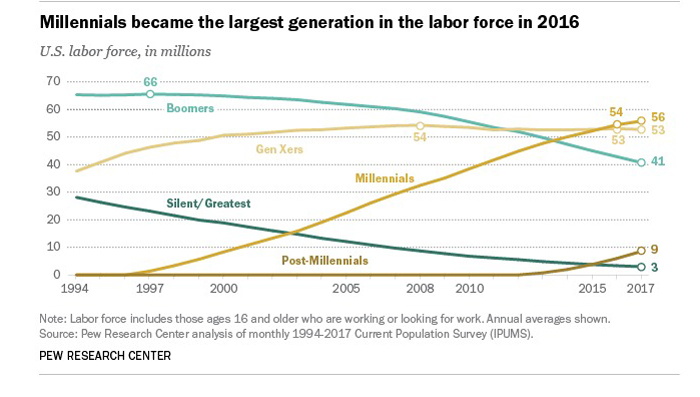
Source - Pew Research Org
Possible Fixes
- Go to Google Search Console and track the posts that have low traffic. The next step is to update the content with the latest update and relaunch your content with the latest information and statistics. Add missing insights from the latest news or add the missing pain points that will solve the query of the user. You can also further add a FAQs section in the post which can boost your chances of getting a higher ranking in the snippets.
- We highly recommend you not stuff keywords forcefully. Amalgamate them in a natural flow of the content. Add eye-catching visuals, GIFs, or videos that will keep the reader hooked to your post. By following these few steps, you can breathe new life into the blog posts and aim to rank higher in the SERPs.
Over-stuffing of Keyword
For anyone who believes that adding keywords to the content or over optimizing will bring the content to top search results are living in a different era. Yes, keywords are a vital part of an SEO strategy. But over-stuffing the keywords in every third or fourth line of the content will land you in big trouble, even a penalty. Google considers it as spammy as it makes your content look very unappealing to the audience.
Here's an example of content with an over-stuffing keyword.

Source - Giftblooms
Possible Fixes
- As per our content marketing experts, we suggest you to write the content from an audience's perspective. Don't write the content by cramming the keywords in the content, as it makes it invaluable. The best strategy to avoid keyword stuffing is to use them where it makes sense, where it relates to the audience, and where it fits naturally.
- The thumb rule is to write the content and compare how much value it offers to the customers. Besides, use long-tail variation keywords that match the user's query.
Site Speed
Site speed is a crucial factor that will affect the rankings in a major way. Google will rank the pages higher that load faster and provide efficient results. Think from a user perspective, if a website is slow in displaying the results, the user will hop on to the other relevant website.
Slow page speed tends to frustrate the users and thereby increase the bounce rate. In addition to that, Google also considers your website's Core Web Vitals that assist in analyzing the real loading time for the visitors, and therefore using this data decides your rankings in SERPs.
Here's an example of a slow site speed website.

Source - Page Speed Insights
Possible Fixes
There are easy ways to fix the site speed.
- Upgrade your hosting plans and opt for 8GB RAM or more.
- Limit the number of installed plugins.
- Test the speed of the website using Google Speed Insight. The analysis report will present to you the causes behind the slow response. Fix them, and your website will run smoothly.
Missing Location-Specific Elements
If you are into a business that targets local customers within a specific city or region, then it is important to understand the value local SEO offers. As per the statistics by Hubspot, 50% of smartphone users visit the local business every 24 hours. So if your business has not claimed or added any location-specific business, then consumers will never be able to reach out for your products or services.
Here's an example of missing location-specific elements.

Source - Google My Business
Possible Fixes
- To solve this SEO error, register in famous business directories that will list your business online with all the necessary information. You can also create a My Google Business account and set up the profile. It's a noteworthy local SEO tactic that will stir up the visibility of your business in the targeted region.
- Start collecting testimonials and feedback from the customers and aim to receive high-quality backlinks. If the business has multiple locations, then create unique content for each My Google Business Page.
- By conducting the above few methods, you can hold a strong base for your local searches and even generate more conversions.
Missing Mobile Optimization
In December 2018, Google announced mobile-first indexing that comprised half of the websites from the search results.
Look around yourself, from kids to the elderly, almost everyone has mobile phones through which they can access information anytime and anywhere. Aren't they the targeted audience? A well-mobile-optimized website decides your ranking. 52.2% of all website traffic worldwide comes from mobile phones.
Here's an example of missing mobile optimization.

Source - Mobile Friendly Test
Possible Fixes
- If your website has not undergone the mobile-first indexing transition, you can use the Google URL Inspection tool.
- Next up, test your website in different browsers, mobile phones, and tablets. Ensure that the design is user-friendly with smooth navigation features and visible information.
- Add the structure data to the mobile pages and update the mobile URLs.
Pages Without Secured Connection
Having an HTTPS and SSL certificate is not merely for security purposes. In fact, Google prioritizes the websites that offer secure connections and helps them to up their ranking.
When a user enters a domain in the search bar, it will display NOT SECURE with a red background and a warning message. This could easily scare away the user from your website.
Here's an example of a website without a secure connection.
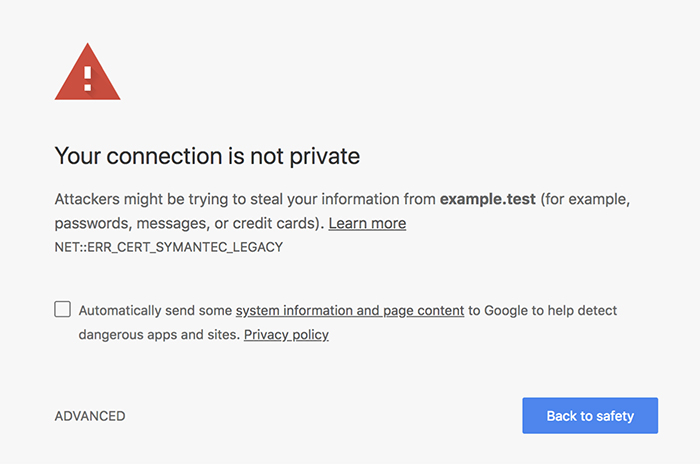
Source - Google
Possible Fix
- The step to quickly fix this error is to buy an SSL certificate from a certified authority and then install it on the website to make it secure.
It will look something like this.

Source - Search Engine Journal
Meta Description Exceeding the Prescribed Length
Businesses work tirelessly to improve the content, yet they ignore the most basic yet super important factors that will affect the rankings. We are talking about meta descriptions.
Here's what Google has to say about Meta Descriptions
A meta description tag generally informs and interests users with a short, relevant summary of what a particular page is about. They are like a pitch that convinces the user that the page is exactly what they're looking for.
Meta descriptions are the short 150-160 character content description that conveys what your web page is all about. Through these little snippets, search engines are able to crawl and index your page. A well-written meta description can provoke the user to click on content on the website.
Similar to your page content, marketers should also optimize the meta descriptions with relevant keywords and no exceeding length.
Here's an example of a meta description exceeding the prescribed length.

Source - Google
Possible Fixes
Here are some possible ways to fix this issues;
- Run an SEO audit to find out all the pages that are missing meta descriptions and the ones that exceed after 160.
- Always use a sentence case. For each page, write a unique meta description.
- Do not use click-bait descriptions
- Make sure that the meta description summarizes your content appropriately.
Meta Title Tag
The meta title tag is a core element for on-page SEO. It helps the engine crawlers in understanding the context of your page. Marketers should focus on accurately describing the title tags and accurately presenting what the page is all about. Additionally, the meta description should represent the content in brief. Failing to do so can produce low search results, fewer website visitors, and few ROI conversions.

Source - Google
Possible Fix
- To avoid this mishap from happening, ensure that each page of the website has a unique title tag and appropriate meta description. Incorporate relevant keywords in the tag so that the crawlers can identify your website.
Improper URLs
Google wants to send users to websites that will provide a phenomenal experience. One of the criteria that decide is the URL structure.
Let's take an example. Which website do you think Google will rank in terms of URL?
- https://www.toystore.com/productnumber1=somecode/
- https//www.toystore.com/category/productname/brand
Google will not consider the former URL and shove it for poor rankings. While the latter will have more opportunities to outrank in the SERPs.
Possible Fixes
- Use full words in the URL
- Avoid numbers and stop words in the URL
- Add the necessary keyword in the URL
- Integrate the categories
Value Less Redirects
When you shift or delete anything from your website, you want your visitors to arrive at the new location that provides value. By integrating a redirect function, it automatically sends the users to the new location.
However, placing ambiguous redirects could actually result in low traffic and increased bounce rate and page speed. If the redirect URL provides little or no value, then cleaning them up is the ultimate solution.
Here's an example of value-less redirects.

Source - Connection We Solve IT
Possible Fixes
- Using the Google Console crawl stats feature to identify which pages are popping up with 404 errors.
- Do not link a page that has a redirect on it. The cycle of redirects will continue leaving the user frustrated.
- Always clear the cache.
- Many times, plugins can also result in redirects, so ensure to remove the plugins that are not required.
- Conduct regular scans or SEO audits, especially after moving to a new hosting provider.
A Few Common SEO Mistakes in Conversion and Tips to Fix Them
With so many SEO resources available on the internet, the most pressing question that businesses often wonder about is how to avoid a few SEO mistakes in conversion. Well, the tactics will not do overnight magic. However, regularly practicing them can help you secure a rank in the SERPs. Let's get started!
No Analytics
It's easy to get caught up in implementing all the strategies without any direction. Here's where an effective solution of using analytics will put you on the right track. Using web analytics software will give you data and insights about what's working in your favor.

Source - GoodFirms
Some of the most famous tools are Google Analytics and Google Search Console, which help you in bringing your best foot forward. Disregarding data and analytics reports can be detrimental to your website's rankings. Consider blending analytics tools within your website to fetch the data and thereby tweak your strategies.
No Attention Towards Local Search
In the sophomore days of local SEO, it was super quick to fabricate the information, incorporate the keywords, fake listing, fallacious locations, and so forth.
The digital era has brought an evolution, especially for local businesses. Through local SEO, businesses are able to address their targeted audiences locally. Additionally, My Business permits local businesses to showcase their profile in their current environment.
Users are constantly browsing information on their phones about their surroundings. Hence, it's an opportunity worth not missing. Businesses of all sizes and types should benefit from local SEO by optimizing the content with location-specific keywords and utilizing My Business.
Keyword Optimization
One of the top priorities of any business is to have organic traffic. To nail this parameter, having a strong content strategy will give a signal to the algorithms to rank your site in the SERPs. A strong keyword optimization strategy will help you build a content strategy through consistent research, finding, and usage of relevant keywords.
But if it isn't, then it will not drive the potential traffic to your website.
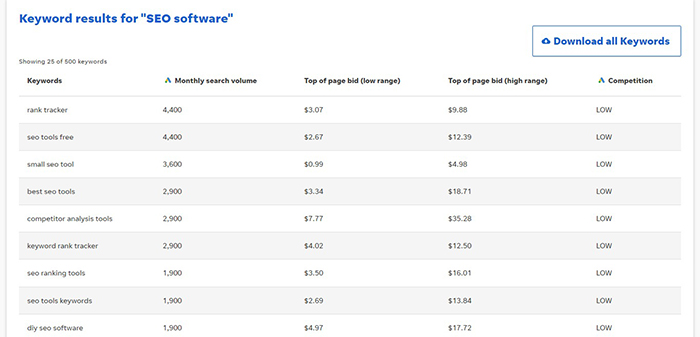
Source - WordStream
Possible Fixes
- The first step is to find the relevant keywords that are connected to your content. You can perform this process through different keyword planners tools like Google Keyword Planner or SEMrush.
- Once the research is completed, start applying keywords at the right placements. Avoid keyword stuffing, instead, use them even in the Anchor Text to catch the attention of search engine algorithms.
- Aside from that, if your keyword optimization efforts are going in vain, then consider rebuilding your content strategy that could give better results.
Lack of Elements in Setting Targeted Audience
As content marketers, it is our responsibility to make sure that the content is appealing enough for our targeted audience. Unfortunately, even the most skilled marketers fall prey to not finding the targeted audience and poor engagement and reach.

Source - Ubersuggest
Possible Fixes
Here's a possible solution for fixing the lacking elements that target a set of audiences.
- To get started, understand who you are creating the content for.
- What type of topics is currently relevant?
- Understand the demographics for the content customization
- Where do you plan to scale your content? Which platforms do you plan to distribute?
- To stir up engagement with the users, schedule email campaigns, polls, and surveys.
Poor graphics
Poor graphics can take away the essence of any website. Additionally, it can also make your website look amateur, and cause hindrance in traffic generation.
Here's an example of poor graphics.

Source - Berkshire Hathaway Inc
Possible Fixes
- To improve the quality of graphics with strong SEO appeal, here are a few possible fixes that you can implement.
- Design the visuals that are correlated to your content.
- Compress the image files. High-resolution images tend to take time in page loading speed. Hence, ensure that the images are optimized and compressed so that they can load quickly on all the applications.
- If you are adding videos, then consider adding transcriptions or subtitles, as it will keep the user engagement and viewership.
Poor UX/UI
The last thing you would want is to neglect user experience (UX), which is an incredible part of a successful SEO strategy. As search engines continue to evolve and bring in the best bits, focus on how users interact with the website to determine its ranking in SERPs.
Here's an example of Poor UX/UI.
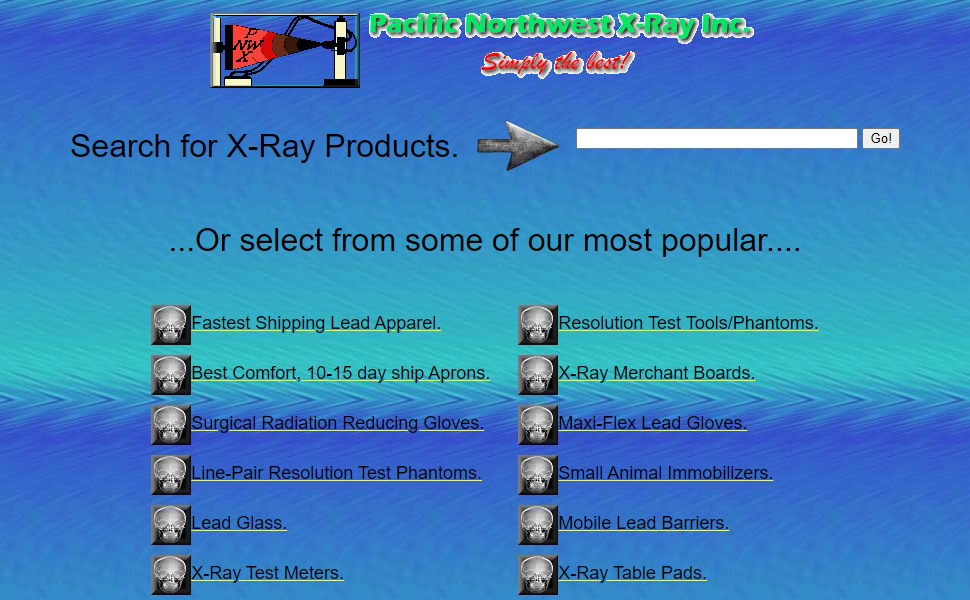
Source - Pacific Northwest X-Ray Clinic
Possible Fixes
- In order to have a smooth UX, make sure that the page loads quickly with easy-to-use navigation. In addition to that, pay close attention to the color palette, fonts, and overall design. Nowadays, businesses tend to follow minimalist designs in web applications.
- PRO-TIP - create structured content that's easy to read and gives an apt solution to the customer's query. If a user is having a hard time navigating and finding the right piece of information, they will move on to another website.
Fake reviews
Businesses involving reviewing products and services can expect positive and negative feedback. The more the number of reviews, the more your business will collect social proof and boost the local search engine factors.
Positive reviews can largely impact your business and overall branding. But having fake yet positive reviews can make it look suspicious to Google. At the same time, customers expressing negative experiences can drive away the traffic.
Here's an example of fake reviews.
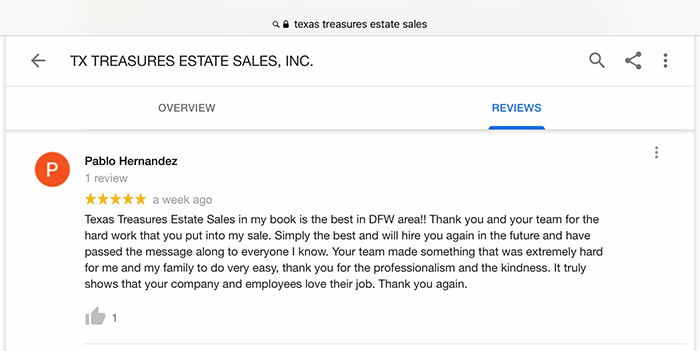
Source - Google
Possible Fixes
- While you can avoid fabricating fake reviews from multiple sources. You can use negative reviews to build a strong customer relationship and understand the audience better.
- Be open to acknowledging the queries of the users and collect genuine reviews from the customers.
Unwanted Articles
Unwanted articles can leave a negative effect and clog up the rankings. Unwanted articles are also known as thin content that keeps appearing for numerous reasons like copy-paste, using too many quotations, duplication of content, article directories, and so on.
The end result is that it becomes harder for the users to find the original source of the content that has genuine information.
Possible Fixes
- Identify the poor-quality content that has no relevant information and consider removing them from your website.
- Pay attention to the traffic data as it will show the results of which articles are successful and which are not working well.
- Do not add unrelated links to the content, as it can come off as a manipulation in the rankings.
- If there are any unwanted articles, then set them up for 301 redirects. It's a permanent redirect that will inform search engines to move visitors from the old page to the new page. Use tools that detect unwanted or scrapped content from the websites.
What are the Underlying Secrets of SEO?
There is a myriad of factors that influence your rankings in search engine page results. Google confirmed some of these factors by mentioning them frequently in the algorithm updates. But there's a lot of guesswork involved out there, especially for marketers.
In such circumstances, what should one do?
Well, you shift focus on what you can control and start prioritizing on-page SEO.
Let's start off by understanding the basics of on-page SEO and learn more about its importance and tactics as we move forward in the blog.
On-Page SEO
On-Page SEO, also known as on-site SEO, is the technique of optimizing the elements of your website. It enables search engine bots to analyze what your page is all about.
By optimizing or altering some of the elements like meta titles, and meta descriptions, or tweaking the internal link structure of your website, there are high stakes your website will gain traffic and rankings in SERPs.
Why Should Businesses Focus on Optimizing On-Page SEO?
On-Page SEO assists the search engines in analyzing your website, and its content to verify that the user's search query is relevant to your site. Over the decades, Google has upgraded its search engine algorithm more than 5,000 times and run over 800,000 experiments. Due to this reason, it's evident that every marketer must follow the guidelines and lay emphasis on optimizing the website for top rankings in SERPs.
One of the primary goals of Google is to deliver search results as per the user's intent and provide a satisfactory experience. Therefore, it is essential that your website denotes optimization to its content, images, and other media that are visible to search engines, like HTML, metadata, and so forth. This way, search engines are able to decipher your website and provide the ranking for the same. The search engine selects the website based on the keywords used for indexing and ranking. Additionally, with on-page SEO, you have full authority to set the goal for each page. You can decide on a set of keywords for the page you want to rank, along with the targeted audience.
Off-Page SEO
Off-page SEO, also known as off-site SEO, refers to the set of actions that helps improve the rankings of your website. These methods or techniques, however, work beyond your website. For instance, getting links from other high-authority websites, increased number of shares or mentions on social media, and so on. Through off-page SEO, Google will predict what your website visitors think about your website.
One of the most governing factors in building a strong off-page strategy is to build quality backlinks. These links should have strong relevancy and indexing with brilliant content so that linking them to your website will enable higher ranking in the search engines.
Why Should Businesses Focus on Optimizing Off-Page SEO?
As we mentioned earlier, the algorithms, ranking factors, and strategies are constantly evolving. However, prioritizing relevancy, reliability, and authority in an off-page strategy will immensely affect the page's ability to rank.
To position your website higher in SERPs, building strong visibility is a prerequisite. Failing to do so can hamper the website's performance, and users might not find your website worth it.
One way of letting your users find your website is by building quality backlinks and then placing them on social media pages, forums, and other platforms of high authority. In addition to partnering with other social media platforms, you can also answer on the forums that bring in traffic and get recognized by other users about your website.
Technical SEO
Technical SEO is all about crawling and indexing the website and includes other elements like canonical tags, page speed, crawl optimization, JavaScripts, and other elements that are covered under technical SEO.
Why Should Businesses Focus on Optimizing Technical SEO?
Applying Technical SEO techniques in your strategy will primarily aid your business in driving traffic and more conversions. A well-crafted technical SEO strategy will help the crawlers to find your website
Applying technical SEO tactics in your strategy will primarily aid your business in driving more conversions and traffic. A well-crafted technical SEO strategy will ensure that your website is crawled and indexed by Google and even other search engines.
You can possibly have the best content in the world, but if the technical foundation is not strong, and no reputable links, then your business will not be successful. Hence it becomes utmost essential for businesses to perform technical audits for the best optimization.
Still, you can go wrong with SEO - How and The possible fixes:
When it comes to SEO, one has to learn how to set the right SEO goals for the business. It's crucial to remember that SEO gives ROI in the long run. Even the most zealous marketers will heighten their expectations, and this can result in disappointment.
To avoid such pitfalls, a sound goal-setting strategy should align with your business objectives. Marketers should conduct SWOT Analysis and consider the Ahrefs THE SEO GOAL PYRAMID.

Source - Ahrefs
Here's how you can incorporate it into your marketing strategy.
- Outcome goal - The outcome goal is the ultimate vision of your project. What goals do you want to achieve for your business in the dedicated time frame? Be clear and precise while setting the outcome of the goal.
- Performance Goal - Performance goals refer to the breakage of outcome goals that can be achieved in a short time span.
- Process Goals - Process goals will assist you in achieving the performance goals. These are the smaller goals that will contribute towards achieving the ultimate SEO goal.
Not Knowing Your Competitors
Not knowing your competitors can make a huge difference in the success ratio of the business. It can reduce the traffic, and ranking, and even result downward in terms of conversions.

Source - Moz
The first step is to figure out who your competitors are and what type of products or services are being promoted in Google. This will give you an overview of ranking keywords, competitors, and targeted customers.
Next, research every competitor and look closely at their blogs and social media engagement. You will gain additional information and opportunities that your competitors might have overlooked.
No Regular Site Audits
Tracking the SEO metrics is important to analyze how effective the efforts are. Start by measuring the performance of keywords, content, campaigns, and other factors that are responsible for the SERP rankings. Failing to do so, will lead you nowhere, and the cycle of why-is-my-website-not-ranking will continue.
To avoid falling into this loophole, use web analytics tools that will allow you to measure the performance and find where you need to create room for improvement.
Ignoring the Trends and Innovations
In 2023, the world is changing at the speed of light. From AI to machine learning - new trends and innovations will shape tomorrow's future. Businesses that fail to acknowledge and ignore the trends and innovation will face severe consequences in terms of SERPs and even building connections with the audience.
How Should Businesses Accept Trends and Innovations?
In the last couple of years, SEO has entered a new battleground. The digital ecosystem is bringing in new tech changes like machine learning and artificial intelligence (AI) that strengthens the gap between consumers and brands in an efficient way.
Additionally, businesses can also stay updated with Google Trends, where they can know about the latest trends ongoing in the world.

Source - Google Trends
By going hand in hand with the trends and innovations, it's possible to generate description snippets that are visible on the top of search results. Another arena where AI and machine learning could be useful is in website rankings. Instead of considering keyword density and backlinks, the algorithms will use intelligent capabilities in understanding the input from the users, and their behavioral patterns and then present the content they wish to read and share.
Not Using the Right SEO Software
Utilizing search engine optimization practices is essential for the growth of the business. However, certain marketers are hesitant in using SEO software. It could be possible that it's not worth the money, or they simply do not understand its value. But the truth is that not investing in fully-featured SEO software can bring frustration in the long run.

Source - Goodfirms
Search engine optimization software assists businesses in improving their visibility in the SERPs. The process of SEO constantly evolves with the latest algorithm updates and different ranking factors. These changes help the users in solving their queries with the utmost accurate results.
Through SEO software, businesses are able to track down their results and understand potential errors without any manual help. It also suggests solutions that will assist you in beating the competition and gaining top rankings in the search results. Still confused about this? Check the latest list of the most-reviewed search engine optimization (SEO) tools as listed by GoodFirms.
Conclusion
It's simple if a page cannot be indexed, then it will not be visible in the search results. When your website is optimized from the front end to the back end, it is bound to receive a higher position in the SERPs. But amidst the way, we tend to make mistakes in the process.
Everything from broken links and copied content to poor keyword optimization - marketers must monitor each page consistently and fix possible errors. Implementing the right set of SEO techniques is the ultimate benchmark for your sustainable digital presence. With some careful considerations and crafting an effective SEO strategy, effective results can be seen for the business. To learn more about the best SEO software, check out our software directory.

